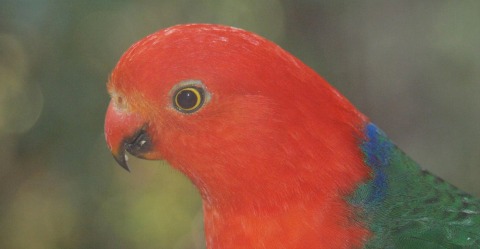Home | About CCW | Contact Us | Climate change Meaning | Causes | Solutions | Emissions | Carbon trading
What adaptive capacity means under climate change
Adaptive capacity is a technical term from ecology and evolutionary biology that describes the ability of an organism to be flexible as conditions change.
Some organisms respond to what the environment throws at them by altering their behaviours and growth patterns to give them the best chance of survival. These are the adaptive species that are good at exploiting disturbed environments.
Plants that do this and interrupt agriculture or our gardens we call weeds.
When environmental conditions are stable and predictable for long periods many species become highly specialised, squeezed into narrow ways of life by competition from other species. They persist because they are best adapted to that particular niche.
Specialisation works to combat competition but then leaves species vulnerable to environmental changes.
This is a male king parrot [Alisterus scapularis] a fairly common species on the east coast of Australia that is on the increase as it breeds well in suburban gardens — it will readily come to bird feeders when there are no other parrots or lorikeets around
Other species shift location, food sources, growth patterns and/or reproductive rates to conserve energy and resources for survival. These species are less successful competitors than the specialists when conditions are stable but do well when conditions are changeable.
Being flexible is an important attribute when the climate is changing.
Importance of climate change for adaptive capacity
Climate change affects conditions for many organisms testing their ability to adapt.
Some of the more likely impacts across a range of habitats and locations include changes to the frequency, timing and intensity of
- disturbance, especially from severe weather events including severe storms and cyclones and wild fires
- frosts and cold snaps
- heat waves
- droughts
- seasonality
And then there are local effects from
- desertification
- rising sea levels
- melting glaciers
- wildfire
- ocean acidification
- changing snow cover
These effects are all part of the normal disturbance pattern and on their own they are just part of what makes nature tick. Each organism that we see in existence today is present because it has coped with historical disturbance.
Each species has a certain evolved tolerance to the disturbance pattern. Any given wildfire might injure or kill many individuals but it does not make the species go extinct.
It becomes a problem when the disturbance regime changes. When events become more frequent, intense or widespread. There are fewer safe places and lesss tome to recover.
This is when the limits of adaptive capacity are stretched. It it goes too far it can be a reason for biodiversity loss
Human ability to be adaptive
Humans are, of course, highly adaptive.
We have figured out ways to survive and be successful in the coldest, hottest, wettest and driest parts of the planet. We even managed to adapt in ancient times before we had the benefit of fossil fuels, limitless electricity and technology.
Our skills with fire, water management and now with technological innovation mean that we are easily the most successful organism on the planet. So much so that we have changed our environment and ignore our innate adaptive capacity.
We now have recreated an environment that provides our primary needs in a safe, sheltered way. Homes, agriculture, medical services and education mean that we have everything we need to carry on being adaptive.
But to get to this ultimate uber-adaptive capcity we have altered the natural world dramatically. We have also grown in number to 7 billion+.
Climate change will be a challenge even for us. Partly because of these changes it will test our flexibility and ingenuity will be tested to the limit as resource availability struggles to keep up with demand.
We might not want to, but we will have to adapt again.
Related pages on climate-change-wisdom...
Links to the science
If you would like to find out more, click on the authors below that link to some scientific papers on this topic...
Armitage, D. (2005). Adaptive capacity and community-based natural resource management. Environmental Management 35(6) 703-715
Engle, N. L. (2011). Adaptive capacity and its assessment. Global Environmental Change, 21(2), 647–656.
Gallopín, G. C. (2006). Linkages between vulnerability, resilience, and adaptive capacity. Global Environmental Change, 16(3), 293–303.
The links go to the websites of the publishers of this material. In some cases it is possible to find out more by entering the title of the paper into Google Scholar.
climate change wisdom › solutions › adaptive capacity
Recent Articles
-
Reducing emissions while looking for solutions...
Nov 01, 15 04:46 PM
I've seen a lot of post's online for ideas on reducing emissions. The one suggestion I have not seen, is the most obvious. There should be a government -
Climate change evidence
Mar 24, 15 06:22 AM
Real climate change evidence has to demonstrate a change in climate. An extra sunny day or a severe storm or a flood is not enough. -
The climate change effect
Feb 19, 15 03:08 AM
What will be the climate change effect? There isn't one, there are many. Perhaps too many for us to understand.



New! Comments
Have your say about what you just read! Leave me a comment in the box below.